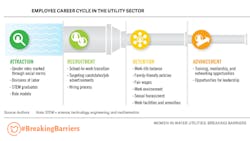About the author:
Arianna Berry is a freelance writer for Water & Wastes Digest. Berry can be reached at [email protected] or 904.451.1565.
Diversity, Equity, and Inclusion (DEI) initiatives are evolving in the American workforce. In 2020, Tony Parrott, CEO of Louisville and Jefferson County Metropolitan Sewer District, spoke to the need for utilities to assess whether their internal climates and cultures support equity and inclusion. He said he had “seen numerous calls for equity” and drew a direct correlation: “the nation’s need for equity relates specifically to the water sector.”
Prior to Parrott’s declaration, a Brookings report (Kane & Tomer, 2018) found that while some individual water utility companies may have a more diverse staff, the water workforce is still lacking diversity nationally. It also outlined how employers struggle to recruit and retain the younger and more varied workers necessary to counter the aging workforce’s “silver tide” of retirements.
Sourcing Diverse Talent
To source diverse new talent, utilities may need to start thinking outside the box according to Randy Hayman, Commissioner and CEO of the Philadelphia Water Department.
“We have to learn to fish in a different pond,” he said. “If we’ve been going to the same place, looking for the same people, you’re not going to find a difference.”
Samantha Williams, External Affairs Manager at Missouri American Water, agreed.
“If the NBA can find basketball players in the middle of nowhere,” she said, “we can source for water industry people.”
What is Balance & Belonging?
Identifying a new generation of workers is especially crucial to the water sector. Industry surveys find it under-represents women in many positions and over 72% of workers are white. And yet, “women” and “white” reflect only inherent or internal diversity (e.g., gender or race). In truth, there are many more dimensions of diversity that fall under categories such as external, organizational or functional, and worldview or cognitive.
“To continue making progress,” Equitable Design leader Aubrey Blanche said, “we’ve got to go beyond our sometimes limited associations with [the term] diversity.”
The limitations of the conventional interpretations of DEI have prompted many employers to reframe the work to additionally encompass a concept of “Balance and Belonging.” Aubrey said that pursuing diversity is not about how many people of a specific demographic are represented at the company level, but rather about creating teams with balanced perspectives, which prompts consideration of the experiences of those excluded from limited diversity definitions. Helping everyone feel like they have a stake in the conversation fosters a sense of belonging. Consultant Christianne Garofalo further explained.
“Diversity is a fact,” Garofalo said. “Inclusion is a behavior. But belonging is the emotional outcome that people want in their organization.”
Diversity, inclusion and belonging must coexist to create an authentic and supportive work culture. Companies are increasingly looking beyond business needs to focus on people and to encourage and accept diverse viewpoints.
A 2019 EY Belonging Barometer study of more than 1,000 employed adult Americans established that diversity and belonging are workplace expectations. Nearly half of respondents believe that diversity is best represented at work, and over one-third feel the greatest sense of belonging at work. According to noted diversity expert Howard J. Ross, when there is a sense of belonging in the workplace, “people have a shared identity, destiny, values and interdependence and feel comfortable being their true selves.”
Communicating Diversely & Inclusively
Creating the sense of physiological safety that fosters belonging in the workplace may ultimately boil down to planning and persistent communication. Williams suggests approaching DEI initiatives with the same intentionality and due diligence dedicated to planning water projects.
“Remember that your people are equally as important as the pipes that you lay in the ground,” Williams said. “There’s a remarkable amount of prep work to implement a pipe-laying project successfully.”
In addition to planning, a successful effort requires buy-in from leadership and a positive organizational narrative around belonging and the value of diversity. Are executives, upper and lower management, and crews all conveying the same messaging? Form an internally and externally cohesive communication strategy and make sure all tiers of all offices align. Consistent communication allows employees to internalize the narrative, and when diversity, inclusion and belonging are frequently discussed, they become a shared language.
To supplement pre-existing DEI initiatives, consider building organizational structures and systems that create inclusive communities. Acknowledge everyone’s contribution and encourage divergent thinkers, as cognitive diversity can counter blind spots, stagnation, and the risk of obsolescence.
Allowing employees space to present dissenting opinions and challenge entrenched thinking without threat to status promotes a sense of belonging.
“In our utility,” Parrott said, “we have created an equity core team, where every division has an equity liaison, that is helping us develop an equity action plan.”
The utility also implemented “courageous conversations” (currently virtual due to COVID) for employees to openly discuss race, civil unrest, and social justice issues.
How DEI and balance and belonging are approached and embodied internally affects external communications, and consumers will compare what organizations say with what they do. It is essential that a utility organization’s workforce reflects and supports community diversity. Refine communications to pull people in instead of excluding them, and make sure that customer education pieces positively reflect that narrative.
An Example With Actionable Change
Williams said to be prepared to discuss social responsibility and DEI policies and how they are incorporated into districts, and when courageous conversations come up, be prepared to listen. For example, when third-grader Zoe Pinaire from Glendale, Missouri, saw a “Men Working” sign, she wrote a letter to Glendale City Hall. As a result, Missouri American Water immediately changed the signs to instead read “Utility Work Ahead” and elevated the suggestion to the corporate level for country-wide review.
She also recommended that External Affairs representatives are brought to the table alongside the Engineer and Finance Director early on during project planning. These trained communications professionals can help to identify opportunities to implement strategies that convey a company’s commitment to diverse representation.
The same strategies are employed whether approaching diverse communities in rural communities or big cities, she said. When interacting with the community, the approach should be, “I hear you, here’s what I’m hearing, here’s how we can partner together, here’s how we’re making proactive investments.”
This is especially true with older, more established cities.
Five Tips For Industry Professionals
1. Don’t be tone deaf. Tone-deaf communications fail to reflect on the state of the external environment. Alternatively, use language that does not acknowledge cultural context. Seek to know consumers and their communities well enough to understand their values. Also, be thoughtful about the content calendar. Is the timing appropriate for the messaging, or is it a bad day to send out news to this community?
2. Customer education pieces are for future users and talent, not just current users. Work diversity into communications to attract diversity, as people respond to visual communications that reflect their
own diversity.
3. Learn from other utilities. Reach out to subsidiaries for best practices and host regional calls to share lessons from outreach efforts in the area. The goal is to humanize people. Most water industry assets are underground, so humanize employees instead.
4. When planning events, consider diversity. For example, consider the community’s prevailing religion and avoid scheduling events when members may be unavailable because of services. Or if there are many senior citizens, consider hosting your event at a grocery store: it may be ADA accessible, on public transit, and serve as a one-stop-shop for seniors to pay bills and get groceries.
5. Be more humanizing, endearing, and inclusive. Understand the nuances of the community’s language and be sensitive to English as a Second Language communities, which can be reluctant to open the door and hesitant to give information to government representatives. Consider partnering with a respected local organization seen as a trusted voice in the community and notify elected officials before starting a project.
The water industry particularly stands to benefit from taking up the important work of addressing issues of DEI and balance and belonging.
“Silence is complicity,” Parrott said, “and so, it is time for you to step up and show that you’re serious about making changes. Utilities must assess and change their internal climates and culture to support equity and inclusion. It’s also important that there’s a commitment to make sure that the workforce mirrors the community across the organization’s breadth and depth. And it goes broader than just the utility. It has to be in the community.”
Additional Suggested Resources
- HR: Job Accommodation Network (https://askjan.org/) provides an A-to-Z list of disabilities and accommodations to build a more inclusive workforce.
- World Bank Report on Women in the Water Industry (https://www.worldbank.org/en/news/feature/2019/08/27/breaking-barriers)
- EY Global Belonging Brochure (https://assets.ey.com/content/dam/ey-sites/ey-com/en_us/topics/diversity/ey-global-belonging-brochure.pdf?download)
REFERENCES
- Kane, J. W., &; Tomer, A. (2018). (rep.). Renewing the Water Workforce: Improving water infrastructure and creating a pipeline to opportunity (pp. 1–72). Washington, D.C.: Metropolitan Policy Program.
- Loop, T., & Nance, R. (2020, September 21). WOW: Conversations on Equity… With Cathy Bailey, Randy Hayman, and Tony Parrott. other. Retrieved from https://wordsonwaterwef.com/2020/09/21/wow-conversations-on-equity-with-cathy-bailey-randy-hayman-and-tony-parrott/.
- Dean, A. D. (2021, September 16). ‘Men working’ signs could be a thing of the past thanks in part to a local third grader. ksdk.com. Retrieved January 3, 2022, from https://www.ksdk.com/article/entertainment/television/show-me-st-louis/men-working-signs-could-be-a-thing-of-the-past/63-beab060c-49fe-4184-aac7-927197ad297a
- Twaronite, K. (2019, May 11). Five findings on the importance of belonging. EY. Retrieved January 3, 2022, from https://www.ey.com/en_us/diversity-inclusiveness/ey-belonging-barometer-workplace-study
- Gurchiek, K. (2019, August 16). Inclusion at work starts with creating pathways to belonging. SHRM. Retrieved January 3, 2022, from https://www.shrm.org/resourcesandtools/hr-topics/behavioral-competencies/global-and-cultural-effectiveness/pages/inclusion-at-work-starts-with-creating-pathways-to-belonging.aspx
- Cultivating a sense of belonging in the workplace. Cook Ross. (2020, June 18). Retrieved January 3, 2022, from https://cookross.com/blog/cultivating-a-sense-of-belonging-in-the-workplace/


